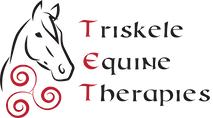Myofascial Kinetic Lines, it’s all connected!
- Bonnie Sweeney
- May 8, 2024
- 3 min read
The topic of Myofascial kinetic lines (MKL) is vast and would require more than a single blog post to cover, but this aspect of the anatomy is so powerful to keep in mind when doing bodywork I can’t simply not write about it.
When we look at the horse from a dysfunctional point of view, it is so easy to break them down into parts and forget about the whole. The owner tells us the horse is having problems engaging the hind end, so we look at the hind end. Equally they say the horse has tension in the poll and is struggling to flex, so we look at the head and the top of the neck. What if I told you the same anatomical connection could be causing both these problems.
The more I delve into anatomy and its complexity, the more I realize nothing in the body is in an island, and it’s all interconnected. MKL is a fantastic example of this.
Fascia, in a very simplified explanation, is a type of connective tissue in the body. Where it was once thought to be relatively unimportant, we now know that it is an interconnected web. This web contains force transmission and dynamic and static contractility. Thus it affects posture, balance, and movement.

MKLs are interconnections of muscle, tendon and fascia and create basic motion patterns in the body. They are the lines upon which movement, posture and balance is created and maintained. Because of their interconnected nature dysfunction anywhere along these lines of interconnection can create dysfunction further along the same line. Considering these lines create and influence flexion, extension, lateral bending and rotation, the effect on the body can be profound.
In horses seven lines have been identified:
Superficial Dorsal Line (SDL)
Superficial Ventral Line (SVL)
Lateral Line (LL)
Functional Line (FL)
Spiral Line (SL)
Front Limb Protraction Line (FLPL)
Front Limb Retraction Line (FLRL)
I could easily write a post about each of these lines, the structures involved and their function, but to return to our example, a horse that’s struggling in the hind end and in the poll likely has dysfunction somewhere along the SDL. This is probably the most common line I see dysfunction in. In the images labelled as “2” this line is marked in green. Contraction of the SDL will extend the spine and create a hollow outline. While relaxation of the line paired with contraction of the SVL will create a lifting of the back and flexion of the neck. In the images labelled as “2” this is the blue line.
To go even further, some of these lines cross over the midline of the horse, onto the opposite side from which they started. The FL as an example, crosses the midline twice, once at the lumbar, then again back via the pubic bone. FL dysfunction could explain the diagonal pattern of compensation often observed between the hind and forelimbs. E.g. dysfunction in one hind limb may show up as compensation in the opposite forelimb, and vice versa. In the images labelled as “3” these are the blue and light blue lines.

These lines have been identified in humans, horses and dogs, and while there is still much more we can learn about them, they provide a fabulous insight into how the body functions as a whole.
Resources:
Elbrønd, Vibeke Sødring, and Rikke Mark Schultz. "Myofascia-the unexplored tissue: Myofascial kinetic lines in horses, a model for describing locomotion using comparative dissection studies derived from human lines." Medical Research Archives 3 (2015).
Neven, A. Colles, C. Paolo, T. (2020) Animal Osteopathy: A Comprehensive Guide to the Osteopathic Treatment of Animals and Birds. Handspring Publishing.







Comments